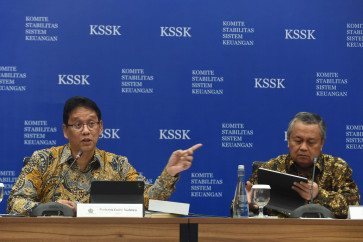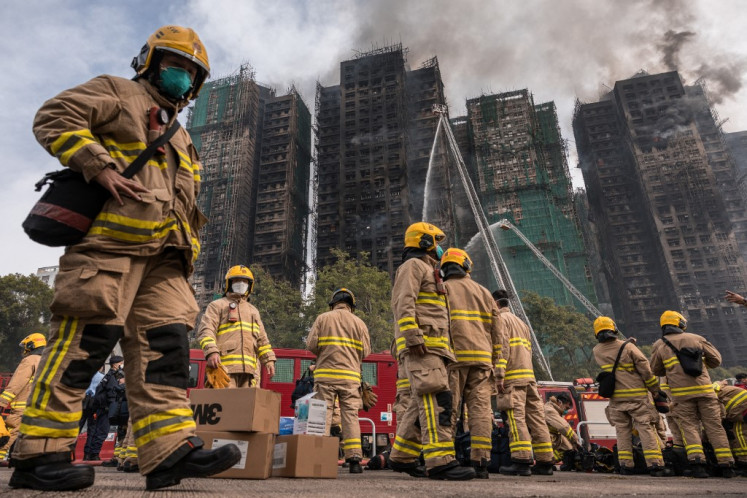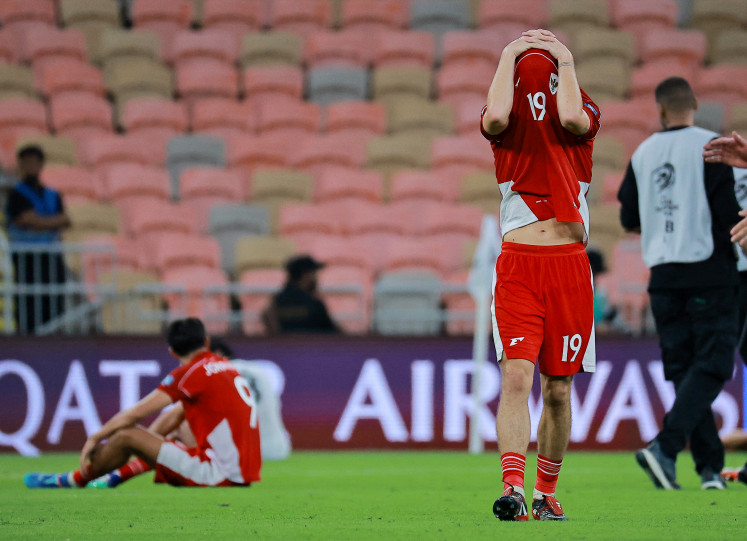Popular Reads
Top Results
Can't find what you're looking for?
View all search resultsPopular Reads
Top Results
Can't find what you're looking for?
View all search resultsTravel: Surabaya, city of parks and arts
Lung of the city: Bungkul Park is one of the most popular hangout spots in Surabaya, East Java
Change text size
Gift Premium Articles
to Anyone
L
ung of the city: Bungkul Park is one of the most popular hangout spots in Surabaya, East Java. Aside from standard recreational facilities, the park’s free Wi-Fi means it’s alive with visitors practically 24 hours a day. (Courtesy of Nurul Fitri Hapsari)
This article was coauthored by Sekar Danty Salsabila, Khaudi Risnaputri Nasution, Widya Mela Ameliyah and Dinda Dhea Sheftya, M. Fadhli Muttaqin, students of Surabaya-based Airlangga University’s English Diploma Program, School of Vocational Studies.
Until a decade ago, Surabaya carried the stigma of a dirty, chaotic city. Strolling through the streets of the country’s second largest city, you would have to shield your nose from the obnoxious stench emanating from its rivers and gutters. Green, open spaces were a rarity. The sweltering heat all year round won it mockery as the country’s “hottest city”. People would struggle to name one decent place or two when you asked them where to go for sightseeing.
Not any more. Today, with a population of over 3 million, the “City of Heroes” is spotless. On fine days, pedestrians are seen ambling on wide walkways and on the banks of realigned rivers. If you happen to see nose-holding pedestrians, the culprit may be the exhaust fumes from the heavy traffic.
Take a jog along the city’s thoroughfares between August and October to enjoy tabebuia in full bloom. Many admirers have mistaken the beauties for the Japanese sakura and the rare plants have been facetiously called the “sakura of Surabaya”. The city has transformed itself from an arid port city into a green flowery metropolis.
The more livable Surabaya has been credited largely to Mayor Tri Rismaharini. Popularly known as Risma, she is the city’s first female mayor and has been in office since 2010. She is on her second and last term. Her most acclaimed work is the beautification of the historic industrial city, which has won numerous national and international honors. In December, Surabaya won the Online Popular City award from @GuangzhouAward 2018.
Artistry: A corner of Friendship Park, one of the best known parks in Surabaya. Ample green spaces make Surabaya a more livable city. (JP/Muhammad Fadhli Muttaqin)Surabaya has earmarked one-third of its 35,000 hectares for green open spaces. Town folks and visitors find the about 100 parks comfort zones to play, chill out, study or exercise. The 3,800 ha Bratang Flora Park, for example, is a popular place to learn about plants that attracts kindergarteners and college students alike. Visitors may sunbathe by the fishpond, learn about compost-making and read books in the library. Children can not only thrill themselves at the playground but also learn about gardening.
Parks are under proper care. To attract visitors, every one of them is provided with free Wi-Fi. Like in developed countries, public facilities have been built for people not only to loosen up but also to do more serious activities like business.
Thematic
In Surabaya, each park has a distinct theme and visitors will have different experiences from visiting them.
Bungkul Park is probably the best, offering a religious and historic ambience apart from the standard recreational facilities. Located at the posh quarters of Jl. Darmo, the park was named after Sunan Bungkul aka Ki Ageng Supo, a cleric who propagated Islam in East Java in the final years of the Hindu Majapahit kingdom in the 15th century. His remains were buried at the site and his grave is considered sacred by some spiritual communities.
In colonial times, the site was part of Dutch real estate. In the early 2000s, it was remodeled as a modern park and opened to the public in 2007 with more recreational facilities added, such as skateboarding, BMX and jogging tracks, an amphitheater, free Wi-Fi access, a playground and food court.
The park never sleeps. Visitors use 5 gigabites a day of the free internet provided by Telkom, according to the state-owned company. A regular visitor, Ademasy writes on a tripadvisor.com page: “It is pretty interesting here in Bungkul Park; there are so many night activities. Every night this place is full of people for different purposes, such as hanging out with friends. The cuisines are also various.” Local foodies come here for the signature rawon (beef soup).
Decent messages: An alleyway to Jarak, a former red light district in Surabaya, is decorated with murals containing various messages from the dangers of narcotics to the virtues of a clean neighborhood. (JP/Pandaya)In the eastern suburb of Sukolilo, the shady Bamboo Forest is a famous spot, where visitors cool down under the lush tall groves and enjoy an “autumn” vibe — that is the sight of falling maple leaves especially during a breezy day. The forest is so thick that little sunlight can get through. The shade, the rustling leaves and the breeze give you peace of mind. Just a few years ago, this little forest was a big garbage dump.
As a coastal city, Surabaya boasts only one fairly decent beach, Kenjeran, which is popular as a family outing spot. In the past, this place was dirty and unkempt. As the city prospers, it has been revamped as a tourist destination. Access to the area has been improved. More buses reach the area and decent eateries have sprung up.
The main attraction is Atlantis Land, where fun seekers can play indoor futsal, swim, ride horses and watch milkfish in ponds. At dusk, people enjoy the sunset at Suramadu Bridge that links Surabaya and Madura Island.
Brothels No More
If you know Surabaya intimately and your next trip will be the first in five years, you will probably not recognize the infamous Gang Dolly (Dolly Alley). Until mid-2014, the area would come to life when the sun set and the alleyways would be bathed in colorful lights; the sound of music would vie for your attention and ladies of the night would wait for customers on sofas in dimly lit houses of ill repute.
This redlight district that started the flesh business in the Dutch colonial era housed about 1,500 prostitutes in 2014 before Risma closed it down. It has shed its reputation as Southeast Asia’s largest brothel. It’s now a tourist attraction. Seriously.
Many residents still retain “Rumah tinggal” (household) signs on their front doors to tell passers-by that the houses are no bordellos.
Full of life: Children play soccer at Bungkul Park, Surabaya. (Courtesy of Nurul Fitri Hapsari)Today, at Gang Dolly you have a great variety of spots to choose, from a mural kampung to a batik center — all run by entrepreneurs. The walls have been adorned with colorful murals with all stripes of messages from antidrug slogans to community cleanliness. The arts are reminiscent of La Fresque des Quebecois in Canada, Ihwa Mural Village in South Korea or Georgetown in Penang, Malaysia.
The art works are part of a collaboration between the city administration, Harapan Drawing Association and Surabaya Creative Network. On the walls, people also scribble their wishes and constructive criticism of their city.
Business at Gang Dolly is robust. The prime mover is probably the Putat Jaya Batik House, which started as a place where former prostitutes were trained in batik-making to help them shift profession. The efforts paid off. The works sold like hot cakes. In 2017, the batik house won a provincial competition.
The Gang Dolly batik motif is distinct. It signifies the transformation of the women’s life from prostitution to dignified professions — all illustrated by the batik motif as the metamorphosis from caterpillars to butterflies.
The six-storey Wisma Barbara, which stands out in the crowded Gang Dolly quarter, has shifted function from a glittery bordello to a shoe factory. Next to it is the Broadband Learning Center that offers computer training.
When it comes to innovation, many regions should look to Surabaya.













